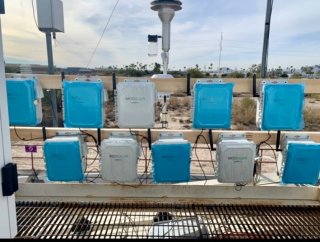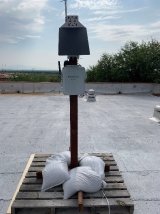Pima County, Arizona
Air Monitoring Grant Update
|
Pollutant(s) of Interest |
PM1, PM2.5, PM10, CO, O₃, NO, NO₂ |
|---|---|
|
Primary Objective |
Establish a network of low-cost sensors measuring particulate matter and gaseous pollutants in Tucson area schools for the purpose of constructing spatiotemporal models to predict air pollution levels across Pima County, and developing community science education plans at schools to educate student. |
|
# of New Devices |
20 |
|
Monitoring Device(s) |
QuantAQ MODULAIR monitor |
|
Primary grantee contact |
Pima County Department of Environmental Quality |
|
Key grant partners |
University of Arizona Mel and Enid Zuckerman College of Public Health (MEZCOPH); University of Arizona Asthma & Airway Disease Research Center (A2DRC); University of Arizona Southwest Environmental Health Sciences Center (SWEHSC) |
|
More Information |
https://www.pima.gov/3328/School-Based-Air-Quality-Monitoring-Prog |

Courtesy of Pima County
Through an EPA IRA grant, the county is working with public school districts all around Tucson to allow 20 non-regulatory sensor-based monitoring sites on school property. These monitors will collect data from localized parts of the county. This includes both high- and low-income neighborhoods, and urban and residential areas, providing both the grantees and the general public with comparable air quality measurements from diverse locations.
Each site will include a set of sensors that will be operated and maintained by the county. The sites are specifically located in places that are accessible to students, where they can learn about both what the equipment does, and how to operate and perform upkeep on the equipment.

Courtesy of Pima County
Partners from the university are working to develop a comprehensive multi-disciplinary curriculum that encompasses public health, environmental justice, data analysis and air monitoring. Classes are expected to begin in fall 2025 once all equipment has been installed, and preliminary data is available.
The University of Arizona also plans to use the data to create publicly available spatial modeling that will be tailored to local neighborhoods. This data will help residents navigate air quality, alongside Arizona’s high heat and very dry climate to make important decisions about the best times to do outdoor activities, when to keep windows closed, and how to protect loved ones who are more sensitive the poor air quality. This new data will also help take into account the effect of Tucson’s landfills, highways, and other built environment factors that can influence local public health.
